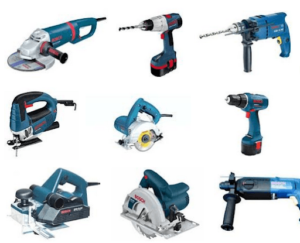How much energy do power tools use?

Power tools have a huge energy appetite . The moment you turn them on, they gobble up more than their share. As a result, you’ve probably tripped a few breakers in your workshop while powering your tools. To ensure you have an adequate power supply for your hungry power tools, it’s best to take a look at the wiring.
How much power do my tools need?
Tools are powered by amps. To check how much yours needs, check the identification plate located on the tool body or motor housing . Find information about AMPS and VOLTS. Make a list of the amps drawn by each tool. Also, take note of any tools that can be wired to run on 240 volts instead of the standard 120.
Typical amperage for small power tools (sander, jigsaw, etc.) is 2 to 8 amps. For larger power tools (milling machine, circular saw, table saw, lathe, etc.), typical amperage is 6 to 16 amps. Some tools like duct collectors and air compressors may require even more power.
Do I have enough energy at home?
Most homes built in the last 40 years have 100 to 200 amp service. This should be enough to run a modern home and shop . Consider having an electrician install a subpanel in your shop so you don’t have to share circuits with the house. This allows for shorter wiring, which decreases energy loss and heat buildup, and also gives you the option to turn off power to the tent when not in use.
If your home was built before 1950, and you haven’t done any electrical upgrades, you probably only have 60 amp service. He should consider upgrading service and installing a new panel to prevent tripping of breakers when operating power tools.
How should I size my circuits?
Start by examining the list you made of your tools’ amperage requirements. Note that electrical codes require that the load on a circuit not exceed 80 percent of its capacity . This means that if you want to run a 16 amp table saw, you need a 20 amp circuit. If you ever run two high-powered tools at the same time, such as a table saw and a dust collector, you need two separate circuits to handle the load.
Should I rewire to 240 volts?
Doubling the voltage from 120 to 240 volts cuts the amp draw in half. This means you can run a 14 amp table saw and a 12 amp dust collector at 13 amps instead of 26, allowing you to run both tools on the same 20 amp, 240 volt circuit. Of course, when pushing the power limits, don’t forget about the non-tool items in your shop, like lights and heaters.
Contrary to common belief, running a power tool on 240 volts instead of 120 does not make it more powerful because, as amplifier usage is cut in half, the wattage stays the same. For example , a 16 amp power tool on a 120 volt circuit consumes 1,920 watts (16×120=1,920). That same tool on a 240 volt circuit now runs on 8 amps and still consumes 1,920 watts (8×240=1,920).
However, they may notice a difference in power if they had been using an 18 amp tool on a 20 amp circuit. Switching to 240 volts decreases the load to 9 amps from the 20 available, ensuring the motor remains at full capacity.
Unless you’re an expert electrician and familiar with local building codes, rewiring your home or store is a job you should leave to a professional.